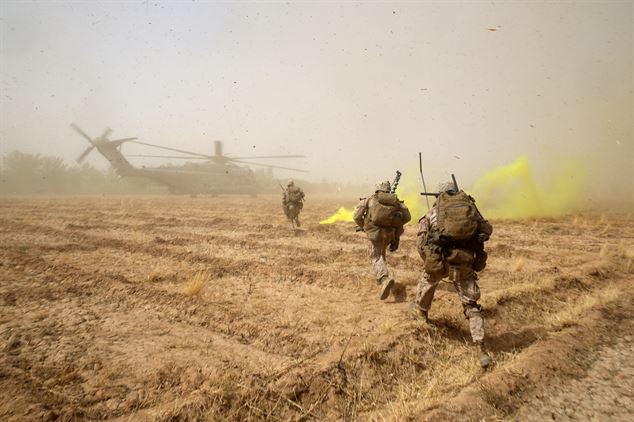Part II: The Case Against Involvement in Afghanistan
In my previous essay, I laid out arguments for continued involvement in Afghanistan. In this essay, I present the opposing view.
The Case Against Involvement
The case for involvement prioritizes future risk; the case against involvement focuses on the considerable cost of past U.S. efforts and the seeming futility of attempts to improve the situation.

Published by The Lawfare Institute
in Cooperation With

In my previous essay, I laid out arguments for continued involvement in Afghanistan. In this essay, I present the opposing view.
The Case Against Involvement
The case for involvement prioritizes future risk; the case against involvement focuses on the considerable cost of past U.S. efforts and the seeming futility of attempts to improve the situation.
The United States has been at war in Afghanistan for almost 16 years. And before the United States intervened, the country suffered a civil war for the better part of 25 years. Clearly, something is deeply wrong. We can postpone defeat, perhaps, or at least slow the Taliban’s momentum, but this history suggests that a complete victory is not in the cards.
The United States has lost more than 2,400 soldiers and Marines–and spent a trillion dollars–during its intervention in Afghanistan. U.S. allies have lost more than 1,000 of their forces. Afghan casualties dwarf these: In 2016, almost 7,000 Afghan soldiers and police died. Since 2009, more than 25,000 Afghan civilians have died, and this year may mark the highest annual death toll yet. Not surprisingly, Afghans feel insecure, which often leads them to work with the Taliban out of fear. In 2006, 40 percent of Afghans feared for their or their families' safety; in 2016, this figure reached 70 percent.
The human cost would be less painful if the United States and the Afghan government were on a path to victory, but this is not the case. Instead, the Taliban are ascendant. Although the group lost many forces, it can recruit new ones and has perhaps 30,000 men under arms. At the end of 2016, the Afghan government controlled only 57 percent of its territory, a dramatic downturn since 2015. (On the bright side, however, the Afghan government controls or influences almost two-thirds of the population because it dominates Afghan cities.) Although the Taliban mostly control remote areas, the Taliban and groups like ISKP can strike in Kabul and other areas of government control, terrorizing the populations across the country.
Efforts to defeat the Taliban failed partly because many Afghans see their government as inept, corrupt, brutal, or all three. The government’s democratic credentials are superficial: the composition more closely resembles a bargain among elites to divvy up power and patronage than leaders who enjoy mass support. No ideology, political party, or charismatic leader unifies Afghans. By design and necessity, local officials hold much of the power. As such, Afghanistan never truly unified under a strong government. Rather, the country’s mountainous geography–and the strong ethnic and tribal identities in many areas–hinder national unity; when Afghans unite, it is often against foreigners. Press freedom is low, as reporters face many dangers. Furthermore, corruption is high. Transparency International ranks Afghanistan as one of the world’s most corrupt countries, and roughly two-thirds of Afghans believe the country is going in the wrong direction. Not surprisingly, the government in Kabul does not engender loyalty, regardless of political leadership–the problem is structural, not personal. Finally, the government’s failures beget further failures. Its inability to rein in corruption, establish the rule of law, provide security, or otherwise perform basic governance functions leads Afghans to turn to local rulers, militias, and the Taliban, further undermining the government’s influence.
In addition, U.S. and allied forces failed to train their Afghan counterparts in large enough numbers to fight the Taliban successfully. Afghanistan’s elite special forces fight well, and plans exist to expand them. However, they represent only 17,000 of the country’s 300,000 military personnel. The Afghan military and police are taking increasingly heavy casualties, losing over 30 people per day. In 2015, the Afghan military casualty figure was more than twice that of 2011. Most of these fighters have little loyalty to their officers and political leaders and evade risking their lives to fight the Taliban. Many flee, desert, or defect rather than fight back.
A political deal seems further away than ever. In 2008, Chairman of the Joint Chiefs of Staff Admiral Mike Mullen declared, “We can’t kill our way to victory.” Yet negotiations made little progress even at the height of the U.S. troop presence. As the Taliban now grow stronger– albeit fitfully–the group is unlikely to be more conciliatory than when they had a weaker hand. Groups like the ISKP, which are more radical, oppose any negotiation. Having a jihadist group to criticize any concession puts pressure on the Taliban politically, and the group’s eagerness to kill through high-profile terrorist attacks poses a threat to any peacemakers. In addition, the Taliban and their Pakistani backers recognize the American public’s growing weariness with the war in Afghanistan. If they believe–perhaps correctly–that time is on their side, they will only be less willing to make a deal.
Pakistan plays a tremendously important and negative role. Pakistan helped the Taliban grow in the 1990s, providing massive financial and military assistance. Thereafter, Pakistani intelligence acted as the Taliban’s “primary patron,” according to the 9/11 Commission. Despite promises to the contrary, Islamabad’s support continued. Since 9/11, Pakistan succored the Taliban, providing a haven from U.S. counterterrorism operations and assistance with fundraising and logistics. This prevents the United States from engaging in the leadership targeting that proved successful in devastating Al Qaeda in Iraq’s ranks at the end of the last decade. Instead, the Taliban’s cadre has a place to train, regroup, and plan–whether laying low to lick their wounds or stepping up operations when they see an opportunity.
The Trump administration took a step forward by making some U.S. aid to Pakistan conditional on ending support for the Taliban, but despite Trump’s desire to force Islamabad to shape up, Pakistan is unlikely to change. Islamabad maintains a strong strategic interest in maintaining a friendly government in Kabul as Afghanistan has long proven a troublesome neighbor. In addition, Pakistan’s military and security services have anti-Western and Islamist influences that favor ignoring Trump’s demands. Finally, on a more local level, border areas between Pakistan and Afghanistan often have little central government presence and strong cross-border tribal ties, which allow terrorist organizations and their allies to operate outside of the Pakistani government’s influence, regardless of Islamabad’s intent. Ending the Pakistani sanctuary completely would a massive change in policy in Islamabad and probably U.S. military operations against groups holed up there.
In addition to the United States’ problems with Pakistan, the U.S. also has a strained relationship with several of Afghanistan’s other neighbors, notably Iran and Russia. For both of these countries, disagreements with the United States over Afghanistan are less important than other issues in contention, such as the Russian aggression in Europe and meddling in U.S. and Western elections or Iran’s support for terrorism and the Assad regime. As a result, pressure on these governments will focus first and foremost on other problems, and they will use anti-U.S. policies in Afghanistan as a way to gain leverage.
In addition, the Taliban may not remain a threat to the United States, even if it wins. The 9/11 attacks proved devastating for the group, and it may have little appetite to bring the United States back to Afghanistan should it kick America out. Their military operations focus on Afghanistan, not the United States. Indeed, the primary terrorist danger stems from Pakistan, not Afghanistan. Al Qaeda is weaker than before, and the U.S. government has carried out far fewer drone strikes in Pakistan in recent years: in 2010, the United States carried out more than 100 drone strikes, but only a handful of strikes in the last few years.
Not surprisingly, the American public is fatigued by the war. Polls suggest that more Americans think the United States is losing in Afghanistan rather than winning and favor reducing U.S. involvement–though the fact that so many respondents reported that they “don’t know” what they think suggests the depressing reality that most Americans simply do not follow America’s longest war.
If the United States departs, then it must consider how to influence Afghanistan to blunt the most dangerous threats. One option is to emulate the Soviet Union after its departure by backing a client government with money and weapons to enable it to survive. Moscow backed the Najibullah regime which managed to hold on in Afghanistan for several years; The United States could mimic this tactic with anti-Taliban forces. The U.S. might further support these anti-Taliban groups with air power and a far smaller number of trainers and special operators, enabling the Afghan government to survive but hardly to advance. Such an inglorious withdrawal would suggest that the blood and treasure spent in Afghanistan were wasted, but that’s not a reason to stay on.
Rather than a full departure, a better option might be a hedging strategy. This would involve a limited number of troops relative to current force levels. They would focus on counterterrorism and on training Afghan forces. In addition, the spigot of U.S. money to Afghanistan would remain open, enabling the government in Kabul to buy allies and keep its current supporters happy. Washington would also try to increase pressure on Pakistan–admittedly, easier as a recommendation than as an objective–while urging the Afghan government to recognize the border between Afghanistan and Pakistan (the “Durand Line”), whose disputed status is a constant irritant to Islamabad. This mix will not solve all the U.S. problems in Afghanistan, but it’s a sustainable way of preserving U.S. interests while limiting U.S. exposure.


.jpg?sfvrsn=407c2736_6)


